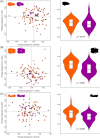Sample Size and Geometric Morphometrics Methodology Impact the Evaluation of Morphological Variation
- PMID: 38313409
- PMCID: PMC10833145
- DOI: 10.1093/iob/obae002
Sample Size and Geometric Morphometrics Methodology Impact the Evaluation of Morphological Variation
Abstract
Geometric morphometrics has had a profound impact on our understanding of morphological evolution. However, factors such as sample size and the views and elements selected for two-dimensional geometric morphometric (2DGM) analyses, which are often dictated by specimen availability and time rather than study design, may affect the outcomes of those analyses. Leveraging large intraspecific sample sizes (n > 70) for two bat species, Lasiurus borealis and Nycticeius humeralis, we evaluate the impact of sample size on calculations of mean shape, shape variance, and centroid size. Additionally, we assessed the concordance of multiple skull 2D views with one another and characterized morphological variation in skull shape in L. borealis and N. humeralis, as well as a closely related species, Lasiurus seminolus. Given that L. seminolus is a morphologically cryptic species with L. borealis, we assessed whether differences in skull shape and in 2DGM approach would allow species discrimination. We found that reducing sample size impacted mean shape and increased shape variance, that shape differences were not consistent across views or skull elements, and that trends shown by the views and elements were not all strongly associated with one another. Further, we found that L. borealis and L. seminolus were statistically different in shape using 2DGM in all views and elements. These results underscore the importance of selecting appropriate sample sizes, 2D views, and elements based on the hypothesis being tested. While there is likely not a generalizable sample size or 2D view that can be employed given the wide variety of research questions and systems evaluated using 2DGM, a generalizable solution to issues with 2DGM presented here is to run preliminary analyses using multiple views, elements, and sample sizes, thus ensuring robust conclusions.
A morfometria geométrica teve um impacto profundo na compreensão da evolução morfológica. No entanto, fatores como o tamanho amostral, vista anatômica e os elementos selecionados para as análises de morfometria geométricas bidimensionais (MG2D), que geralmente são determinados pela disponibilidade de espécimes e de tempo ao invés do design de estudo, podem afetar os resultados dessas análises. Utilizando grandes tamanhos de amostra intraespecífica (n > 70) em duas espécies de morcegos, Lasiurus borealis e Nycticeius humeralis, avaliamos o impacto do tamanho amostral nos cálculos da média e da variância da forma, e do tamanho do centroide. Adicionalmente, avaliamos a concordância entre vários planos 2D do crânio e caracterizamos a variação morfológica da forma cranial em L. borealis e N. humeralis, bem como em uma outra espécie proximamente relacionada, Lasiurus seminolus. Dado que L. seminolus é uma espécie morfologicamente críptica em relação a L. borealis, avaliamos se as diferenças no formato do crânio e na abordagem de MG2D utilizada permitiriam discriminar as espécies. Descobrimos que a redução do tamanho da amostra impactou o formato médio e aumentou a variância da forma, que as diferenças na forma não foram consistentes entre as vistas ou elementos cranianos, e que as tendências apresentadas pelos planos anatômicos e pelos elementos não foram fortemente associadas umas às outras. Adicionalmente, constatamos que as formas de L. borealis e L. seminolus, quantificadas por MG2D, foram estatisticamente diferentes em todas as vistas e elementos. Esses resultados enfatizam a importância em selecionar tamanhos amostrais, vistas 2D e elementos anatômicos adequados, com base na hipótese testada. Devido à grande diversidade de perguntas de pesquisa e de sistemas avaliados com MG2D, provavelmente não exista um tamanho amostral ou vista 2D que possam ser aplicados de forma generalizada. No entanto, uma solução geral para os problemas envolvendo MG2D aqui apresentados é conduzir análises preliminares utilizando várias vistas anatômicas, elementos e tamanhos amostrais, garantindo assim conclusões mais robustas.
© The Author(s) 2024. Published by Oxford University Press on behalf of the Society for Integrative and Comparative Biology.
Conflict of interest statement
None declared.
Figures





References
-
- Adams DC, Collyer ML, Kaliontzopoulou A, Baken EK. 2022. Geomorph: software for geometric morphometric analyses. R package version 4.0.4. https://cran.r-project.org/package=geomorph.
-
- Baken EK, Collyer ML, Kaliontzopoulou A, Adams DC. 2021. geomorph v4.0 and gmShiny: enhanced analytics and a new graphical interface for a comprehensive morphometric experience. Methods Ecol Evol 12:2355–63.
-
- Bookstein FL. 1991. Morphometric tools for landmark data. Cambridge, England: Cambridge University Press.
LinkOut - more resources
Full Text Sources
